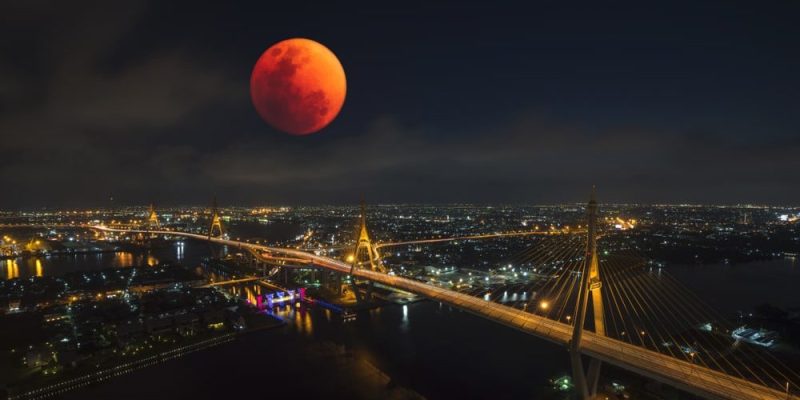We explain what the blood moon is, how often it occurs and the origin of its name. Also, why is it not dangerous to look at it.

What is a blood moon?
It is popularly known as the red moon or blood moon. a type of lunar eclipse, in which the Earth's satellite does not completely darken but it acquires certain copper, red or brown tones. This phenomenon occurs when two different events coincide:
- When there is a total lunar eclipse that is, when during a period of full Moon, the Earth comes between sunlight and the Earth's satellite, submerging the latter in a cone of almost total shadow.
- When the Earth's atmosphere contains high levels of pollution, cloudiness or interference of another type, capable of absorbing certain wavelengths of sunlight and allowing passage only to the lower spectrum of light, that is, red light.
When both situations coincide, we have a red moon or blood moon that is, a lunar eclipse that, instead of completely overshadowing it, dyes it a reddish tone that can be overwhelming. Otherwise, this phenomenon does not have any particularity or special feature from an astronomical point of view, but it has been observed since ancient times and has been commonly associated with bad omens.
See also: Phases of the Moon
How often is there a blood moon?
“Blood moons” are not entirely predictable, since depend on the date and place from which they can be perceived. After all, it is a lunar eclipse, nothing more. Between two and five lunar eclipses occur each year, although total eclipses are the least frequent of all.
Even so, the probabilities suggest that the next red moons will be on the following dates and places:
- May 16, 2022 visible in North and South America, Europe and Asia.
- November 8, 2022 visible in North and South America, Asia, Australia and the Pacific.
- March 14, 2025 visible in North and South America, Europe, Australia and the Pacific.
- September 7, 2025 visible in Europe, Africa, Asia and Australia.
- March 3, 2026 visible in North and South America, Asia, Australia and the Pacific.
- December 31, 2028 visible in Europe, Africa, Asia, Australia and the Pacific.
- June 26, 2029 visible in North and South America, Africa, Europe and the Middle East.
- December 21, 2029 visible in North and South America, Asia, Europe, Australia and the Pacific.
- April 25, 2032 visible in North America, Asia, Africa, Europe and the Pacific.
- October 18, 2032 visible in North and South America, Asia, Africa, Australia and the Pacific.
Why is it called a “blood moon”?
There are many explanations and stories as to why this type of moon is called a “blood moon”, all associated with tragic or bloody events. In ancient times they were associated with disastrous events which threatened the stability of the universe or the perpetuity of a monarch.
Some biblical versions associate it with the death of Saint John the Baptist when the exotic Idumean princess Salome asked King Herod as a gift, after having performed a dance for him, the head of the prophet John the Baptist on a silver platter.
The monarch, who had imprisoned the prophet to prevent him from turning the people against him (in some versions, because he did not approve of Herod's marriage to his sister Herodias), kept his word and gave the dancer the prophet's severed head. , and just that night the Moon turned red, thus reflecting the holy blood shed.
What happens when there is a blood moon?

When there is a blood moon, you can see a reddish, brown or copper Moon, because Sunlight, upon entering the Earth's atmosphere, is dispersed or distorted upon coming into contact with particles suspended in it, such as ash, carbon dioxide, very dense clouds, among others.
This is because red and orange light has the longest wavelength and slowest frequency, oscillating 430 to 510 times per second. Otherwise, this moon has no difference from any other in the lunar calendar.
Is it dangerous to look at a blood moon?
At all. Unlike solar eclipses, which can damage our retina if we look directly at them, lunar eclipses do not represent any danger since the Moon does not have its own brightness. Its apparent brightness is due to the reflection of sunlight.
Continue with: Celestial bodies
References
- “Lunar eclipse” on Wikipedia.
- “What makes the 'blood moon' red and is it dangerous to look at?” in Independent en Español.
- “Blood Moon: how to see the last partial lunar eclipse in November, the longest of the century” in La Nación (Argentina).
- “What happens when there is a blood moon?” at UNAM Global.
- “What is a Blood Moon?” on Space.com.





